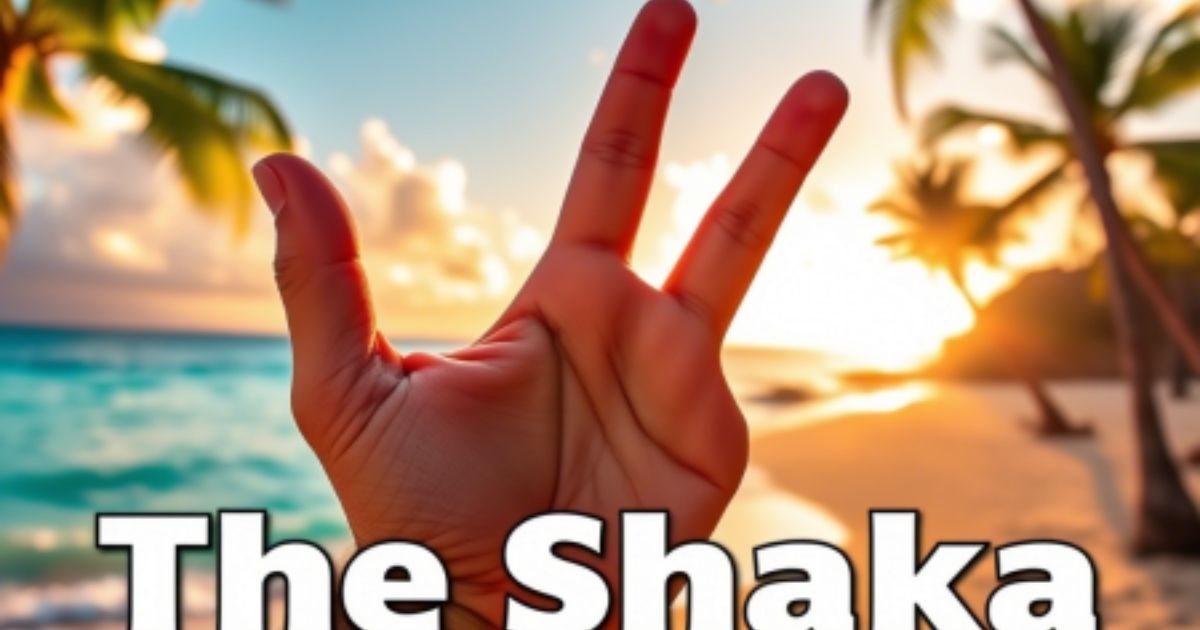The Shaka Hand Sign: A Symbol of Aloha and Hawaiian Culture
In Hawaii, a simple gesture can speak louder than words. The Shaka Hand,thumb and pinky extended while the middle fingers are folded,shares the true spirit of aloha. It’s used every day by locals to greet, thank, or show respect without speaking. The Shaka Hand is more than a friendly wave; it represents kindness, unity, and the laid-back Hawaiian lifestyle. Whether you’re walking along Waikiki, meeting someone on Oahu, or catching a wave at Sunset Beach, this gesture is a symbol of connection and peace.
Though small in form, the Shaka Hand carries deep cultural meaning and a powerful message of goodwill. Its roots trace back to the early 1900s and continue to grow stronger across generations and even outside the islands. In a fast-moving world, the Shaka reminds us to slow down and live with compassion, joy, and gratitude,values that sit at the heart of Hawaiian culture.
The spiritual Meaning of the Shaka
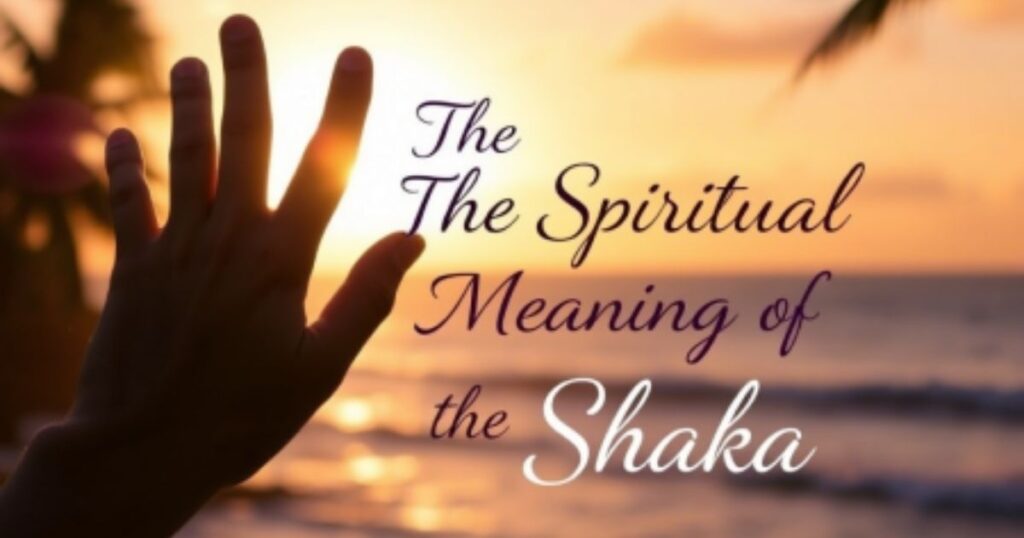
The spiritual meaning of the Shaka goes far beyond just a simple hand sign. It carries the deep spirit of aloha, which means love, kindness, and connection in Hawaiian culture. When someone throws a Shaka, they’re not just saying “hi” or “thanks”,they’re sharing a piece of their heart.
The gesture reminds people to live with compassion, to stay humble, and to treat others with respect. It’s about unity and being in balance with yourself, others, and the world around you. In a way, the Shaka becomes a peaceful reminder to slow down, stay grounded, and live with joy and goodwill.
For many locals, it also honors the strength and spirit of Hamana Kalili, whose life and hand gave this sign meaning. Spiritually, the Shaka represents harmony,it’s a quiet, powerful way to spread light and connection in everyday life.
Hawaiian roots
The Shaka hand sign started in Hawaii. One story says it came from a man named Hamana Kalili who worked at a sugar mill on Oahu. He lost his three middle fingers in an accident. When he waved, only his thumb and pinky showed. Kids copied his wave, and it slowly became a friendly sign across the islands. People used it to say hello, goodbye, or just to show good feelings.
Riding the wave to surf culture
In the 1960s, surfing became popular, and the Shaka became part of the surfing world. Surfers liked it because it matched their chill, friendly style. It said things like “nice wave” or “you’re cool” without using words. The Shaka hand became part of surfer life, not just in Hawaii, but around the world.
The shaka hand became a big part of surf culture in the 1960s, when surfing started growing outside of Hawaii. Surfers from the mainland and other countries visited Hawaiian beaches like Waikiki, Sunset Beach, and Laie. They learned not just how to ride waves but also how to live with the aloha spirit. They saw locals using the shaka to say “hello,” “thank you,” or “nice wave,” and they began doing the same.
In surf culture, the shaka hand became a symbol of respect and good vibes in the water. It was a way to say “all good” or “no problem” without speaking. Surfers would flash it to one another while waiting for waves or after a fun ride. The gesture fits perfectly with the peaceful, laid-back life that surfing promotes. It helped build a feeling of community, friendship, and shared love for the ocean.
As surfers traveled the world, they took the shaka hand with them. It became part of the surf lifestyle in California, Australia, and even in places like Bali. The gesture now connects surfers globally, reminding everyone of surfing’s Hawaiian roots and the values of kindness, respect, and living in the moment. Today, throwing a shocker in the lineup is a sign that you’re not just surfing,you’re spreading aloha.
What Does the Shaka Sign Mean?
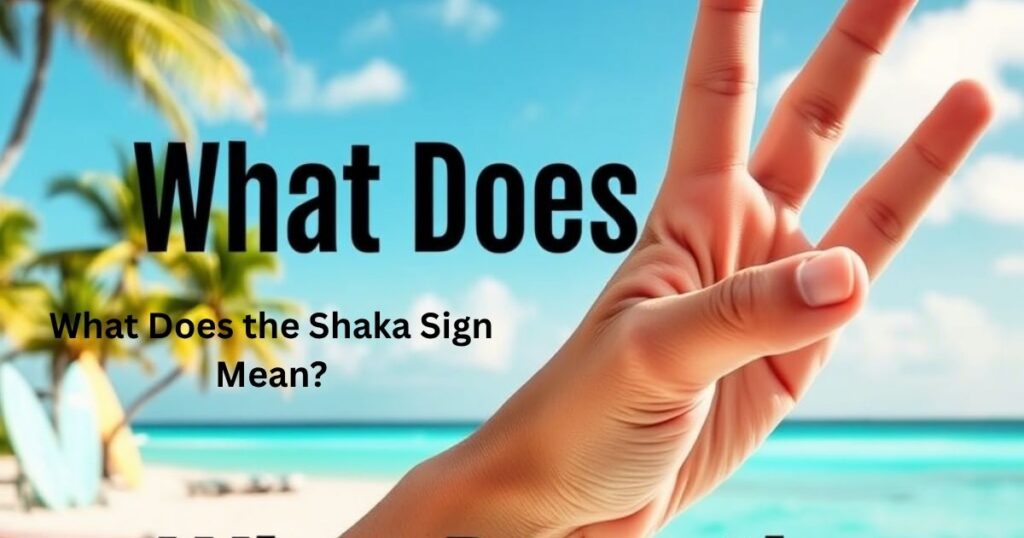
The Shaka hand sign is more than just a wave. It holds a lot of meaning. When someone gives you a Shaka, they are not just saying something simple. They are saying, “I see you, I care, and everything is going to be okay.” The Shaka is a nonverbal way to show appreciation, positivity, and connection. It can say “thank you” when you let someone into traffic or “goodbye” when leaving a party.
In Hawaiian culture, this gesture is a daily part of life. The Shaka stands for unity, compassion, and kindness. It helps build fellowship among strangers and camaraderie among friends. Whether you are a keiki (child) or a kupuna (elder), flashing a Shaka brings smiles and makes people feel good. In this way, the Shaka truly shares the deep aloha spirit.
Read this Also: 11 Spiritual Meaning of Diamonds
Mainstream adoption
By the 1970s, the Shaka was used by everyone, not just surfers. People saw it in ads, on TV, and even in politics. Frank Fasi, a Hawaii mayor, used it in his campaign. Later, shows like SpongeBob made it popular with kids. Now, the Shaka is used in many places,on the beach, on planes, and even in schools and businesses.
The shaka hand started in Hawaii, but it didn’t stay there. In the 1970s, it became more visible thanks to local politicians like Frank Fasi, who used the gesture during his campaigns to connect with the people. It showed he understood the island culture and cared about the community. Soon, the shaka was seen on posters, in commercials, and even on TV shows.
Entertainers like Lippy Espinda helped make the shaka even more popular. His cheerful saying, “Shaka, brah!” became a favorite phrase. He used it during his car commercials and appearances on shows like Hawaii Five-O, making the gesture and phrase stick in people’s minds. From there, the shaka hand started showing up more often in pop culture.
In time, surf culture, tourism, and even airlines like Hawaiian Airlines helped spread the shocker around the United States and beyond. Today, you can see the shaka hand in movies, social media posts, and even corporate branding. It’s now a worldwide sign of chill vibes, friendship, and the spirit of aloha.
Shaka etiquette
When you use the Shaka hand, it’s nice to do it right. Keep your thumb and pinky out, curl the other fingers in, and give it a little shake. In Hawaii,
Thumb pinky out
Gentle hand shake
Backhand facing out
Casual, not forced
Not overused
Use with smile
Respect local use
Add aloha spirit
Situational awareness matters
Keep it friendly
The Origins of the Shaka Hand Sign
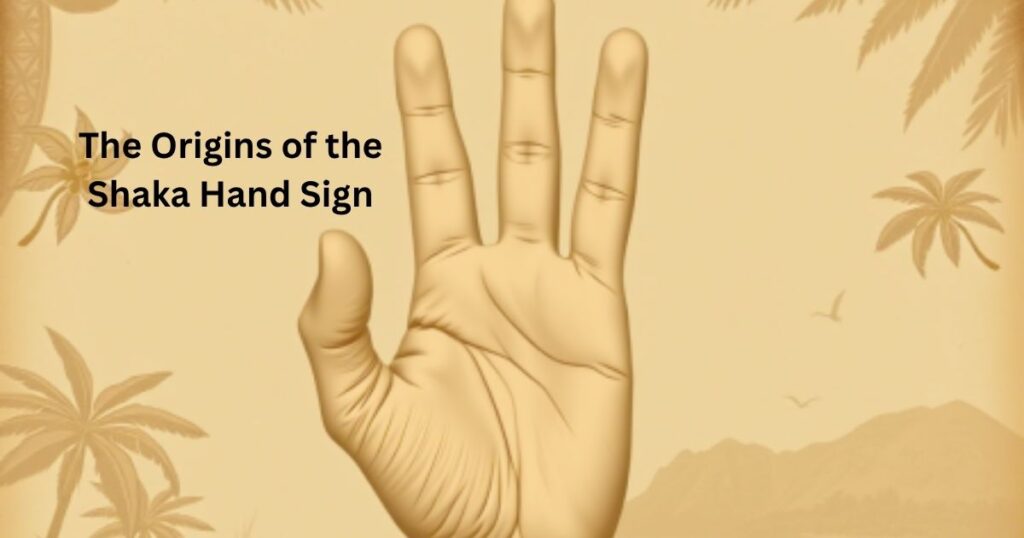
The true origin of the Shaka is not 100% certain, but the most popular story comes from a man named Hamana Kalili. He lived in Laie, on the island of Oahu, in the early 1900s. Kalili worked at the Kahuku Sugar Mill, a big plantation in the area. One day, while working, his right hand got caught in the machinery, and he lost his three middle fingers. After the accident, he could only use his thumb and pinky.
Later, Hamana became a security guard for the train that ran from Sunset Beach to Kaaawa, passing through Kahuku Station. When he waved to stop kids, known as kolohe (mischievous), from jumping on the train, the children started copying his special wave. That unique hand sign became the early Shaka.
Many people also believe that a man named David “Lippy” Espinda, a fun-loving used car salesman in the 1960s, helped to popularize the word “Shaka” in the United States. He ended his TV commercials with the phrase “Shaka, brah!” and the hand sign. The Shaka was later used in Frank Fasi’s 1976 campaign for Mayor of Honolulu, showing how deeply this icon became part of local life. Some also believe that Spanish immigrants used a similar sign, and it slowly changed and blended into Hawaiian tradition.
Hamana Kalili accident
Kahuku Sugar Mill
Lost middle fingers
Train station wave
Laie, Oahu roots
Unique hand gesture
Children copied wave
Local legend grows
Security job story
Early 1900s Hawaii
Beyond the beach
The Shaka hand isn’t just for surfers or the beach. People use it in all kinds of places. You might see it at a music festival, during a hike, or even at work in a friendly office. Skaters, climbers, and snowboarders use it too,it means “nice job” or “good vibes.” On social media, people love using the 🤙 emoji to show good feelings. It’s become a sign of positivity, support, and kindness all over the world.
A universal language
The Shaka hand speaks without words. It’s like a smile,you don’t have to explain it. It connects people from different places and cultures. Whether you’re in Hawaii, California, or even Asia, a Shaka can say “thank you,” “it’s okay,” or “you’re awesome.” It brings people together and spreads the aloha spirit,which means love, respect, and peace.
The shaka hand is more than just a gesture,it’s a universal way to show kindness, connection, and good vibes. Whether you’re in Hawaii, on a beach in California, or even in another country, people recognize the shaka. It crosses language barriers and speaks with emotion. A simple shaka can mean “thank you,” “hello,” or even “no worries.”
What makes the shaka hand so special is how it brings people together. You might see it between strangers in traffic or shared by surfers in the ocean. It says, “We’re all in this together,” without needing any words. In today’s busy world, this small hand sign reminds us to slow down and connect with others through kindness and respect.
Even online, people use the shaka emoji 🤙 to spread aloha. From social media to everyday life, the shaka hand has become a symbol of peace, unity, and shared happiness everywhere, not just in Hawaii.
The Shaka in Hawaiian Surf Culture
Surfing is a huge part of life in Hawaii. It’s more than a sport – it’s a lifestyle that connects people to the ocean, nature, and each other. The Shaka hand sign fits perfectly into this world. In the 1960s, Hawaiian surfers started using the Shaka to say “hang loose,” “all good,” or “nice wave.” It became a symbol of their calm, joyful attitude.
Surf culture spread the Shaka across the world. Surfers from Oahu, Waikiki, and other Hawaiian Islands took the gesture with them to different countries. Soon, the Shaka meant encouragement, solidarity, and a relaxed vibe wherever there were waves. Whether you’re watching a surf competition or just hanging out at the beach, you’ll see the Shaka shared with love.
The Shaka in Everyday Hawaiian Life
In everyday life across Hawaii, you’ll see the Shaka hand sign almost everywhere. Locals use it while driving, at luaus, during hukilau, in schoolyards, and at church events. Even in the LDS Church, where Hamana Kalili was a choir director, people remembered him because of his unique Shaka wave during songs. It became a way for his congregation to recognize him.
From keiki to kupuna, the Shaka is used to show respect, humility, and inclusion. You’ll also see it in logos, local photography, and tourism branding. Businesses often use the Shaka to represent Aloha and a friendly welcome. It’s a daily reminder of pono, which means to live in balance and harmony with others. Through the Shaka, Hawaiians express hope, mindfulness, and open-heartedness.
Spreading the Aloha Spirit Beyond Hawaii
Today, people outside of Hawaii also know and use the Shaka hand sign. Tourists visiting Oahu, Laie, or Honolulu often learn to use the gesture and take it back to their home states in the mainland United States. Some see it in emoji form on their phones or in pictures on social media. It becomes more than just a vacation memory – it’s a way to share goodwill and joy.
The Shaka has traveled far, becoming a part of travel culture, digital communication, and even sign language in some cases. It connects people across the globe who have felt the Aloha spirit. It reminds us to slow down, smile, and treat others with kindness, just like people do in Hawaii every day.
But Where Did the Word “Shaka” Come From?
The hand sign was already used in Hawaii, but the name “Shaka” came later. People believe David “Lippy” Espinda, a local entertainer and car salesman, made it famous. He always said “Shaka, brah!” on TV. This helped make the word popular in Hawaii. Later, Frank Fasi used it in his political campaign. That helped spread the word “Shaka” to the rest of the United States and the world.
How to Perfect Your Shaka
There’s no perfect way to do a Shaka hand, but it should feel relaxed. Not too tight, not too loose. Some people let their fingers hang, others keep it firm. You can give it a little shake for extra aloha spirit. What matters most is your feeling behind it. Use it with kindness, and it’ll always feel right.
Perfecting your shaka starts with the basics. Just curl your middle three fingers into your palm and stick your thumb and pinky out. That’s it. But to really make it feel right, you need to relax your hand. It shouldn’t look stiff or forced. Try a gentle shake or slight movement,it gives the gesture a natural and friendly feel.
Everyone has their own style when it comes to the shaka hand. Some people do it loose, with fingers barely curled. Others like it tight and strong. There’s no strict rule. The most important part is that it feels like you. A shaka that comes from the heart,no matter how it looks,will always feel more genuine than a perfect pose.
You’ll see locals in Hawaii throwing a shaka hand while driving, walking, or even surfing. Practice until it becomes second nature. Add a smile, share some aloha, and you’ll be doing it just right.
Embrace the Shaka,and Hawaii’s Spirit of Aloha
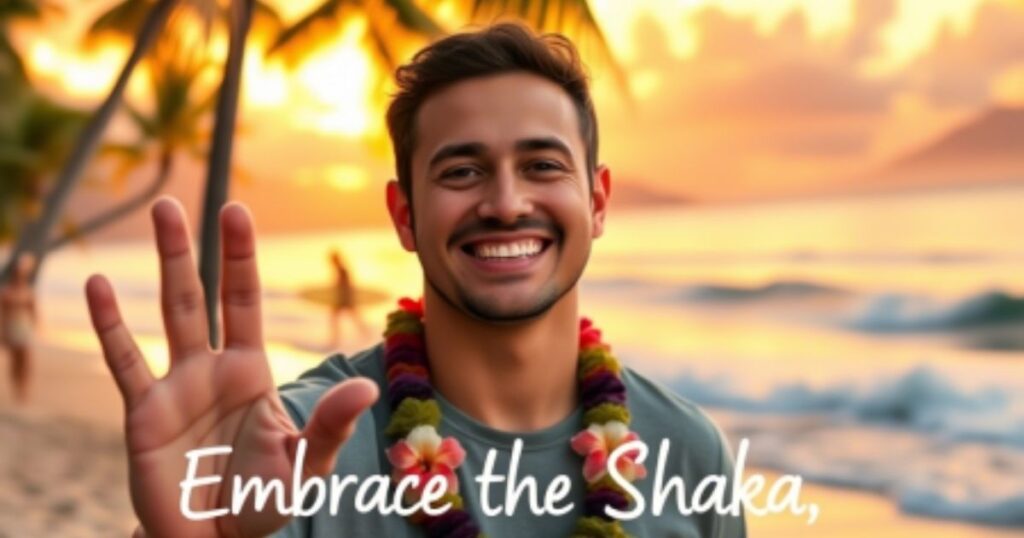
The Shaka hand is more than just a sign. It’s a way to live. It reminds us to be kind, humble, and respectful. It carries the spirit of aloha,which means love, peace, and connection. Whether you’re on an island or far away, a Shaka can bring people together. It’s a small gesture that spreads big meaning. So go ahead,throw a Shaka hand, and share a little joy wherever you are.
The Shaka as a Cultural Touchstone
The Shaka is more than a trend. It’s a lasting part of Hawaiian identity. It holds the values of Aloha, Mahalo (gratitude), and Pono (doing what’s right). It brings people together in a world that often feels divided. This small hand gesture holds deep emotions and a rich history that connects generations.
Thanks to people like Amelia Bennett and newspapers like the Honolulu Star-Bulletin, the story of the Shaka is shared and remembered. From Hamana Kalili’s hand at the Kahuku Mill to surfers flashing the sign after a big wave, the Shaka hand sign continues to be a bright light of Aloha and Hawaiian culture.
FAQ’s
What does the shaka sign symbolize?
The Shaka Hand Sign symbolizes aloha, friendship, kindness, and goodwill. It shows respect, peace, and a relaxed attitude in Hawaiian culture and daily life.
What does shaka mean spiritually?
The Shaka Hand Sign spiritually means living with aloha, showing love, balance, and harmony. It reflects the values of pono, compassion, and positive human connection.
What does ” sign” mean?
The emoji shows The Shaka Hand Sign, meaning hang loose or all is good. It spreads friendly vibes and aloha in texts and online chats.
Why do surfers do it?
Surfers use The Shaka Hand Sign to show chill vibes, respect, and unity. It’s part of surf culture and a way to say everything’s okay.
Is the Shaka Hand Sign only for Hawaiians?
No, anyone can use The Shaka Hand Sign with respect. It has spread worldwide to share aloha, gratitude, and positivity in many places and cultures.
Conclusion
The Shaka Hand is more than just a wave. It is a simple way to show kindness, peace, and respect. People in Hawaii use it every day to say hello, goodbye, or thank you. The Shaka Hand is a big part of Hawaiian life. It helps people feel connected and welcome. From the beach to the streets, this small hand sign shares a big message of aloha.
Today, the Shaka Hand is known all over the world. Surfers, travelers, and locals use it to spread good vibes. It’s not just for Hawaii,it’s for everyone who wants to live with love and respect. The Shaka Hand teaches us to slow down and be kind. No matter where you are, using this hand sign is a way to bring people together. It is a beautiful symbol of unity, happiness, and the true spirit of aloha.

Spiritual Lume is a trusted spiritual blog dedicated to exploring the deeper meanings of life, dreams, and divine signs. We offer thoughtful interpretations of symbols, Bible verses, and spiritual concepts to guide readers on their personal and spiritual journey. At https://spirituallume.com, our mission is to illuminate your path with wisdom, faith, and clarity.

